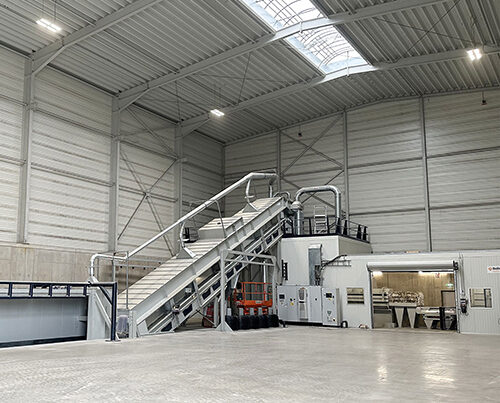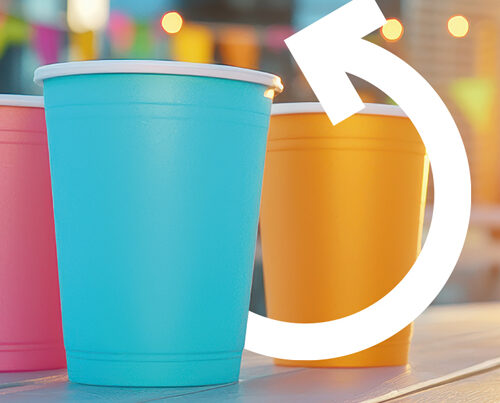In ancient times, when Ötzi ‘The Iceman’ made his way over the Alps (i.e. around 5,300 years ago), clothes were primarily used to protect people from the elements. Leather, fur and plants kept humans warm during the icy winters. A 5,000-year-old, Ancient Egyptian dress – found near Cairo and thought to be the oldest surviving (almost complete) woven garment – clearly shows that people also wore clothes back then to express their individuality. Besides being used nowadays to represent individuality, personal style or conformity, both fashion and clothing have mostly become mass-produced, consumer items. While the art of haute couture found in major French cities, i.e. designing and making expensive, fashionable clothes, is aimed at a select group of people, fast fashion has established itself as a source of inexpensive clothing for the masses, with the bought items being worn for ever shorter periods of time. This is driving up greenhouse gas emissions and energy and raw materials consumption all around the world.
In a nutshell
Old textiles are becoming ever more important within the circular economy as a source of raw materials. More than one million tonnes of old garments are discarded in Germany every year. An EU directive, which came into force in 2025, has made it obligatory for producers to ensure their old garments are collected separately. Working together with partners such as H&M, REMONDIS has been developing schemes that enable old textiles to be sorted and re-used. The mixtures of materials used to make some garments are proving to be a big technological challenge when it comes to recovering the fibres.
More than one million tonnes of textiles end up in clothes banks and collection points every year – an estimated 64% of the volume of clothes that could actually be collected.
On average, consumers in Germany buy 60 garments a year, twelve of which are hardly ever worn. More than one million tonnes of textiles end up in clothes banks and collection points every year – an estimated 64% of the volume of clothes that could actually be collected. The rest is thrown away into the general waste bin, remains hanging in our wardrobes or is passed on to friends and family. Old garments are one of the world’s largest and most important material flows. The textile industry is well aware of the big challenges this is causing and has already begun working with the recycling sector to find solutions to make the garment industry more sustainable.
The used textile market across the EU has been subject to a new regulation since 01 January 2025: according to the EU directive, producers are now responsible for ensuring their old garments are collected separately. Making the recycling of used textiles a statutory obligation means that the market must react quickly and set up a well-functioning recycling infrastructure for old garments. We sat down with Dr Ansgar Fendel, CTO of REMONDIS, to discuss the importance and treatment of old textiles as well as the opportunities created by recycling this huge material flow.
“Both the volumes of garments and the impact they are having on the environment have led to textile recycling becoming one of the big subjects in the circular economy.”
Dr Ansgar Fendel, CTO of REMONDIS

Why is it becoming ever more important to recycle textiles?
Dr Ansgar Fendel: Both the volumes of garments and the impact they are having on the environment have led to textile recycling becoming one of the big subjects in the circular economy. It’s not a question here of WHETHER they should be recycled but HOW; it is essential that old textiles are reused in some form or other. The EU’s goal is to bring about a green transition within the industry. Looking at the amount of old clothing generated, recycling these used textiles will be key to achieving this goal as well as to helping to make raw material supply chains more resilient.
This is clearly illustrated by taking a look at cotton: for the most part, the general public are unaware of the fact that cotton is one of the most important fibres used in the textile sector. Climate change and the impact this is having on the availability of water in the cotton growing regions will potentially change the size of the yields and the quality of the fibres. For this reason alone, it makes absolute sense to produce recycled cotton fibres – even if this is a really complex undertaking.

So what steps has REMONDIS taken to promote textile recycling?
Dr Ansgar Fendel: Our goal is to collect used garments, to sort them in the best possible way and then to return them to market for reuse either as good quality second-hand clothing or as a valuable raw material. We took a hands-on approach here and began setting up this business a few years back. The experience we gathered has proven to be very useful for further developing today’s operations.
During this time, we decided that it would make sense to enter into a strategic, cross-sector partnership with a company operating in the textile industry as this would enable the upcoming tasks to be carried out quicker and better. And this was precisely the reason why Looper Textile Co., our Swedish joint venture with H&M, was founded. This collaboration work with our partner H&M – which is also a family-run firm – is proving to be complementary, successful and very constructive.
I also believe that it is important to create a close-knit, cross-sector network so that the recycling industry can work with the textile sector to solve the upcoming challenges involving this highly complex material flow and so that we can work together to drive forward sustainability in this particular area.
What makes processing textiles so complicated?
Dr Ansgar Fendel: The process of reusing these garments – something that ranges from selling them as second-hand clothing all the way through to recycling them to produce recycled fibres – is a technologically challenging undertaking. There are a number of reasons for this, including the sheer variety, the constant changes being made to the short, fashion-led product cycles and the soft, flexible properties of the textiles themselves.
When we recycle used garments we have to take a whole range of things into account, such as the many highly different types of fabric, the mix of materials in a fabric (from monofibres like cotton, to mixed fibres like polycotton with elastane, through to multilayered fabrics), colours, chemical stabilisers and coatings, adhesives, appliqués, fasteners and buttons as well as the huge range of shapes and sizes.
So how do we deal with this complexity? After the clothes have been collected, we sort them by hand in our highly efficient plants, such as our facility in Polch, and separate them into two groups: second-hand goods and products for recycling. This is always an important step. It might sound easy but this does, in fact, require a high level of product know-how, as we produce and sell over 200 different types of customer-specific qualities for the second-hand market. This work still has to be done by hand at the moment. Between 40% and 50% of the input materials are sent on for recycling as they are not suitable for the second-hand market.
Between 40 and 50% of the input materials are sent on for recycling as they are not suitable for the second-hand market.
And what happens to the garments that are sent on for recycling?
Dr Ansgar Fendel: At the moment, the garments destined for recycling are sorted again by hand so they can be used for industrial applications, e.g. to make soundproofing materials for the automotive sector, cleaning cloths and fleece.
We will soon be replacing this manual sorting work with an automated process. We are currently testing some AI-based sorting technology that we have developed. This system should automatically separate the garments headed for recycling into specific fabric qualities. The next step is then to produce recycled fibres from these materials that can be used by spinning factories to produce thread or for some other high-quality application.
An important but challenging material flow
The fact that fibre to fibre recycling – the ideal way to return recycled fibres to market – is still in the development stage cannot simply be put down to technological reasons. According to Dr Ansgar Fendel, spinning businesses all around the world are still reluctant to use this, for the most part, unknown recycled material.
The company RE-Textil is based in Polch, a town near Koblenz. Every day, it takes in and sorts 20 tonnes of used textiles. After they have been manually pre-sorted, the garments are then sorted again into different quality categories, packed up and exported to countries all around the globe. The firm remains in close contact with
REMONDIS’ trading partners at all times to ensure they deliver the exact qualities needed.
Besides the technological challenges involved, Dr Ansgar Fendel explained that the most important aspect of textile recycling is recognising that this material flow is extremely important, that it will become more and more important in the future and that the conduct of every single person can help combat climate change. When we buy a dress or a jumper, we do not think enough about the impact that the production, logistics and recycling of the garment have on the environment. We all need to consider how we can pass on as many of our old clothes as possible so they can be reused. Furthermore, the decision to purchase a garment and the way we use it also have an impact on our world. At the end of the day, environmental protection also begins with our own conduct – our planet will certainly thank us!

Image credits: image 1: Adobe Stock: Ljupco Smokovski, Iana; image 2: © REMONDIS; image 3, 4: Adobe Stock: Ljupco Smokovski












